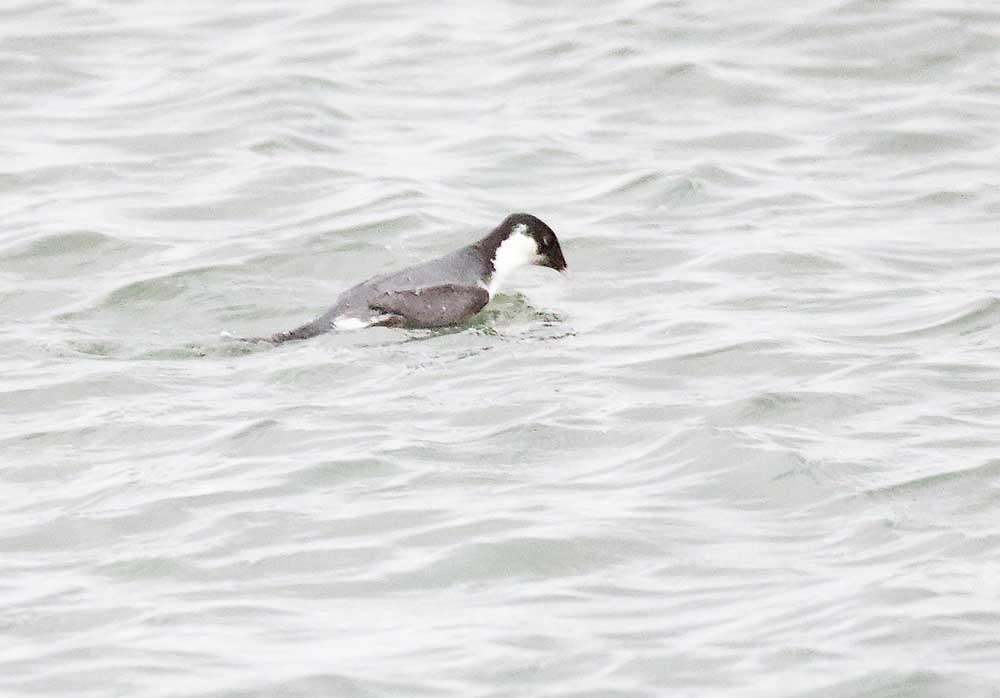Birding: Rare birds of the Port of Peninsula
Published 1:53 pm Wednesday, January 31, 2024

- The ancient murrelet about to dive into the bay looking for a tasty small fish for lunch.
The Port of Peninsula, Nahcotta, has been a great place for seeing uncommon, unusual, or rare birds of late. Barrow’s goldeneye, ancient murrelet and the yellow-billed loon are three species that have been seen recently at the port from the visitor’s parking lot. They are considered rare in Pacific County and on the Long Beach Peninsula.
The Barrow’s goldeneye was one of the unusual birds observed on the Leadbetter Christmas Bird Count on Dec. 16, 2023. In fact, the 2023 sighting on the count day was the first in over forty years. The goldeneye’s behavior, habits and appearance are very similar to that of the common goldeneye. However, there are some differences crucial to IDing the Barrow’s. In general, it has a shorter bill than its cousin which helps to give it a rather stubby appearance. The head shape is more striking looking due to its steeper forehead. The adult male has a purplish head, black vertical shape on the side of the breast, smaller white spots on its scapulars and a diagnostic white crescent shaped patch on its face. The adult female has a mostly yellow bill, and her head is a darker brown than her cousin’s.
On the other hand, the common goldeneye is a medium sized duck with an oversized head. Its bill is black and triangular which adds to the distinctive shape of the head. The adult male’s green head sports a white oval green patch which is diagnostic. The adult female’s head is brown, and her body is gray. The common goldeneye was also seen on our CBC. It is designated as uncommon but not rare or unusual. As noted above, the two species are similar but not the same! Crossley (2021) suggests that birders should always confirm the bill and head shape when IDing goldeneyes.
Ancient murrelet
The ancient murrelet is considered rare in both Pacific County and more specifically on the Long Beach Peninsula. It was seen on Jan. 10, 2024, at the Port of Peninsula swimming furiously against the raging waters of the winter storm and high tides, diving for small fish, and loafing in the waves when they became gentler.
The ancient murrelet is a short, compact seabird with a short, thick neck, broad head, and a bill that is pale at the tip. It is black and white and about the size of a quail. It has a dark face with white wrapped behind the ears! This is the best ID marker for the ancient murrelet. Its back is gray, and it wears a dark cap. Normally, its habitat is the open ocean, but large storms can transport these birds to the coast and, inland. It gets its name from the plumage of the breeding bird.
Ancient murrelets in breeding plumage sport white plumes above their eyes. It is thought that these plumes resemble an old man’s white hair. Hence, the name ancient!
Yellow-billed loon
The other rarity observed at the Port of Peninsula was the yellow-billed loon. We returned to the port on Jan. 11 to see if the ancient murrelet was still there. It wasn’t — but a beautiful, yellow-billed loon was. It too was probably transported in by the winter storms and high tides we were experiencing.
It is an arctic breeder on tundra lakes and ponds and is slightly larger than the common loon by two to three inches. Crossley suggests that it has a regal appearance created by its tipped up upper mandible and angled lower mandible (2021). The bill is ivory in non-breeding birds and yellow in breeding birds. These characteristics are considered an important factor in the IDing of this loon species. Yellow-billed loons typically show a small dark ear patch behind the eye.
I remember looking for days for the yellow-billed loon that wintered in the Ilwaco harbor many years ago. Many birders from came from afar to see it. It was a lifer for many, including me.
I highly recommend checking out the Port of Peninsula. Even if rarities aren’t there you will see other birds. Right now, you could see a common loon, red-throated loon, one of the grebe species, least sandpipers or glaucous-winged gulls to name a few. Check it out! Happy birding!








